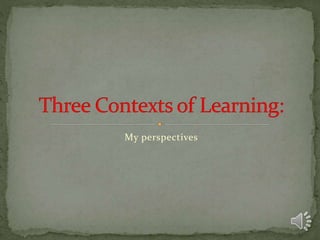
Elena artefact october 13 final
- 2. On completion of this talk learners would be able to discuss formal, informal, and community-based aspects of learning and their role in life-long education
- 3. Learning aspects as “everything from skill upgrading to organizational reform to innovation to critical analysis and organized resistance” (Nesbit et al., 2013, p.227) What is it: informal, non-formal and formal learning – and the boundaries between them
- 4. Learning as a broad term that “refers to any elements that together produce a change in mental constructs or behavior” (Spencer &Lange, 2014, p.7). Education as a formal or “planned” (Spencer & Lange, 2014, p.7) way to obtain knowledge, “the entire body of organized educational processes, whatever the content, level and method, whether formal or otherwise, whether they prolong or replace initial education in schools, colleges and universities as well as apprenticeship, whereby persons regarded as adult by a society to which they belong...” (Spencer & Lange, 2014, p.8).
- 5. Teacher ‘s role in a formal education – “someone presumed to have greater knowledge …when a teacher has the authority to direct designed learners to learn a curriculum taken from a pre-established body of knowledge” (Livingstone, 2007, p.2).
- 6. Selman et al. in The Foundation of Adult Education defined purposes of adult education as following (pp. 29-30): - Academic, credential, and vocational - Personal interest and development - Citizen action and social change
- 8. “43% of Canadian adults aged 25-64 reported being enrolled in some form of adult education” (Knighton, Hujaleh, Iacampo,& Werkneh, 2009, cited in Nesbit et al, 2013, p.239). Livingstone (2007) discussed that “educational courses and intentional informal learning activities related to employment, housework, community volunteer work, and general interests” (p.1) or training in the working setting shifted from “know-how to work process knowledge” (Spencer &Lange, 2014,p.64).
- 9. However: Does this type of learning adds much to “understanding of the production process beyond a particular worker’s own job” (Spencer &Lange, 2014, p.65) – that formal education does?
- 11. Mark Seaman (2008) discussed differences and similarities and roles in adult education of two types of communities: communities of practice and knowledge communities Community of practice as “the set of relations among persons, activity, and the world, over time and in relation with other tangential and overlapping communities of practice” (Jean Lave and Etienne Wenger, 1991, cited by Seaman, 2008, p.270).
- 12. Outsider in a community of practice: “questions such as “How are we relevant to one another?” and “Who are we and where are we going?” are answered first, and by the group itself” (Akerman et al., 2008, p.383).
- 13. Knowledge communities as “personal practical knowledge” (Seaman, 2008, p.271); according to Connelly and Clandinin (1988) is “a particular way of reconstructing the past and the intentions for the future to deal with the exigencies of a present situation” (cited in Seaman, 2008, p.271).
- 14. Akkerman, S., Petter, C., & de Laat, M. (2008) Organising communities-of- practice: facilitating emergence Journal of Workplace Learning 20. 6, 383- 399. DOI:198416199 Retrieved from: http://search.proquest.com/docview/198416199/fulltext/8C535649ADB44 C97PQ/1?accountid=142373 CUV (2005) Aiming high, quality in community learning, guidance for partners, Community University of the Valleys Partnership, Swansea, UK CUV (2005) Aiming high, engaging communities with learning, guidance for partners, Community University of the Valleys Partnership, Swansea, UK. Fenwick, T. (2010) Re-thinking the “thing”: sociomaterial approaches to understanding and researching learning in work, Journal of Workplace Learning 22, No. 1-2, 104-116. Retrieved from: http://search.proquest.com/docview/198504134/fulltext/2F027B9A132849 E0PQ/1?accountid=142373
- 15. Hoskins, B. & Deakin Crick, R. (2010) Competences for learning to learn and active citizenship: different currencies or two sides of the same coin? European Journal of Education 45, No. 1, 2010, Part II, 121-137.Retrieved from:http://search.ebscohost.com/login.aspx?direct=true&AuthType=url, cookie,ip,uid&db=a9h&AN=47842158 Livingstone, D.W. (2007) Re-exploring the icebergs of adult learning: Comparative findings of the 1998 and 2004 Canadian surveys of formal and informal learning practices, The Canadian Journal for the Study of Adult Education 20, No. 2, 1-24. Malcolm, J., Hodkinson, P. & Colley, H. (2003) The interrelationships between informal and formal learning, Journal of Workplace Learning 15, No. 7/8, 313-318. Retrieved from: http://search.proquest.com/docview/198448063/fulltext/85B882ED45784 935PQ/1?accountid=142373
- 16. Nesbit, T., Brigham, S.M., Taber, N. & Gibb, T. (Eds.) (2013) Building on critical traditions: Adult education and learning in Canada. Toronto: Thompson Educational Pub. Seaman, M. (2008). Birds of a feather?: Communities of practice and knowledge communities. Curriculum and Teaching Dialogue, 10(1), 269- 279,306. Retrieved from: http://search.proquest.com/docview/230449414/fulltext/BE2AE8E930634 DFBPQ/1?accountid=142373 Selman, G. et al. (1997). The Foundation of Adult Education in Canada. (2nd Ed.) Thompson Educational Publishing, Inc. Spencer, B. &Lange, E. (2014). The Purposes of Adult Education. An Introduction (3rd Ed.). Toronto: Thompson Educational Publishing Inc.